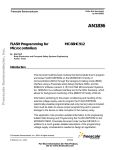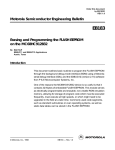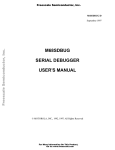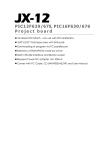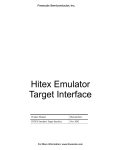Download M68EVB912D60 EVALUATION BOARD USER'S MANUAL
Transcript
M68EVB912D60/D March 1999 M68EVB912D60 EVALUATION BOARD USER'S MANUAL 2nd Edition © MOTOROLA Inc., 1999; All Rights Reserved M68EVB912D60/D Motorola reserves the right to make changes without further notice to any products herein to improve reliability, function or design. Motorola does not assume any liability arising out of the application or use of any product or circuit described herein; neither does it convey any license under its patent rights nor the rights of others. Motorola products are not designed, intended, or authorized for use as components in systems intended for surgical implant into the body, or other applications intended to support or sustain life, or for any other application in which the failure of the Motorola product could create a situation where personal injury or death may occur. Should Buyer purchase or use Motorola products for any such unintended or unauthorized application, Buyer shall indemnify and hold Motorola and its officers, employees, subsidiaries, affiliates, and distributors harmless against all claims, costs, damages, and expenses, and reasonable attorney fees arising out of, directly or indirectly, any claim of personal injury or death associated with such unintended or unauthorized use, even if such claim alleges that Motorola was negligent regarding the design or manufacture of the part. M68EVB912D60/D 2 M68EVB912D60/D * Cautionary Note * EMC Information on M68EVB912D60 This product conforms with the protection requirements of Council Directive 89/336/EEC of 3 May 1989 on the approximation of the laws of the Member States relating to electromagnetic compatibility. (Directive 89/336/EEC amended by Directives 91/263/EEC, 92/31/EEC, 93/68/EEC, 93/97/EEC) 1) This is a Class A product. In a domestic environment this product may cause radio interference in which case the user may be required to take adequate measures. 2) Anti-static precautions must be adhered to when using this product. 3) Connecting any signal cable to this product may affect its performance and also Cause interference with other apparatus in the immediate vicinity. If it is necessary to make any such connections suitable mitigating measures should be taken. M68EVB912D60/D 3 M68EVB912D60/D 1. Introduction This manual provides the necessary information for using the M68EVB912D60 Evaluation Board (EVB), an evaluation and debugging tool for the MC68HC912D60 Microcontroller Unit (MCU) device. The manual includes a general description of the EVB as well as configuration and set-up instructions 2. General Description and Features The EVB can be used in conjunction with an appropriate debugger tool that uses the background debug mode, such as Motorola’s (or Noral’s) Serial Debug Interface (SDI), and compatible debug software such as Motorola’s MCUez or P&E’s SDBUG12. The board consists of a 4 layer PCB which provides the interface and power connections to the MC68HC912D60 microcontroller (MCU). Hardware features include the following: • • • • • • • • • • Single 5 V dc power supply connector RS-232C Interface BDM In connector providing interface to Background Debug Mode 16 MHz oscillator module Prototype expansion area for customised interfacing with the MCU Low-voltage inhibit protection CAN Physical Interface Chargepump for the supply of the flash programming voltage Bargraph LED to assist with debugging 8 way DIP switch to assist with debugging The EVB is factory configured to start in single chip or special single chip mode. It is supplied with the flash EEPROM unprogrammed and can be run with an appropriate debugger, via the Background Debug Mode (BDM) interface. The EVB features a prototype area, which allows custom interfacing with the MCU’s I/O and bus lines. The MCU pins can be accessed via header footprints immediately adjacent to the MCU. An on-board push-button switch, S2, allows the EVB hardware to be manually reset. A CAN physical interface is provided on the board. This comprises of a Philips PCA82C250 CAN Interface controller. M68EVB912D60/D 4 M68EVB912D60/D 3. Hardware Reference 3.1 Power Supply The EVB requires an external +5 volt power supply for operation. Ideally this should be current limited to 200mA. Power is supplied to the EVB via the power socket, P6. A 2.5mm power plug has been included in the M68EVB912D60 kit to allow the user to power the EVB from a standard desktop power supply. To do this the user should solder insulated wires onto the two terminals of the power plug, and then connect the other ends of the wires up to their power supply. Great care should be taken to ensure that the 5 Volt supply is connected to the internal part of the power plug and the Gnd supply is connected to the external barrel of the power plug. To +5V Supply To GND Supply 3.2 BDM In Connector The EVB can be used in conjunction with a suitable Background Debug Mode (BDM) debugger interface, such as the SDI, and appropriate debugger software. The BDM input to the EVB is via jumper J16. Table 3-1 shows the pinout for J16. 3.3 MCU Operating Mode Jumpers J24 and J25 allow the user to select which mode the MCU starts in after reset by controlling the state of the MODA and MODB pins. The default mode is to pull the MCU MODA and MODB pins to ground. This results in the MCU starting from reset in either Single Chip or Special Single Chip mode (dependant on the state of the BKGD pin). The state of the MODA and MODB pins can also be set via the Noral SDI cable. When this option is used it is not necessary to install links on jumpers J24 and J25. 3.4 Clock A 16 MHz oscillator module provides the clock signal to the MCU. Jumper J27 must be installed between pins 1 and 2 (factory default) to configure the clock signal correctly. 3.5 RS-232C Interface An RS-232C interface is provided on the EVB through a 9 way D type connector, P1. Signal level translation between the MCU and P1 is provided by an MC145407 RS-232 interface IC (U3) . This is connected to the TxD and RxD pins of the Serial Communications Interface (SCI) on the MC68HC912D60 via jumpers J11 (TxD) and J9 (RxD). As there are two serial communications interface modules supplied on the MCU, jumpers J9 and J11 can be used to select between them. The EVB has been configured to act as Data Circuit-terminating Equipment (DCE). Removing jumpers J8, J10 and J13 allows the user to disable this function if it is not required. M68EVB912D60/D 5 M68EVB912D60/D 3.6 CAN Physical Interface There is a CAN physical interface supplied on the M68EVB912D60. The CAN physical interface comprises a Philips PCA82C250 CAN Interface controller (U1). The TXD and RXD pins on the PCA82C250 are connected to the CANTX and CANRX pins on the MC68HC912D60 respectively. The CAN bus signals, CANH and CANL are available on jumper J1. Table 3-1 shows the pinout for J1. 3.7 Programming Operation It is possible to configure the M68EVB912D60 as a programming tool. To do this the relevant programming adapter board has to be purchased (contact Motorola for further details). To configure the EVB as a programming tool, the adapter board has to be connected to the header strips on the EVB (when doing this care should be taken to ensure that the adapter board is installed with the correct polarity as failure to do so could result in damage to the device being programmed). It is also necessary to install the jumpers on header P8 in the PGMR position. There are two possible ways of supplying the flash EEPROM programming voltage VFP to the MCU, either via the MAX662 chargepump I.C. (U5), or via the SDI cable. The source of the flash EEPROM programming voltage can be selected via jumper J17. There is an option for controlling the operation of the chargepump I.C. (U5). If there is no jumper link installed on Jumper J14, then the VFP supply will be held at the level of VDD. If a jumper link is installed on Jumper J14 then 12V will be supplied to the VFP pin of the MCU. In addition to this there is an option which allows the user to control the operation of the chargepump I.C. via a port pin of their choice. To do this the user must connect a wire between the pad situated to the right hand side of Jumper J14 and the pad of the port pin they want to use as the controller. When this option is chosen the user must remove the jumper link from jumper J14. J14 From user specified port pin 3.8 Jumper Configuration Table 3-1 summarises the jumper and header configurations for the EVB. Key to Table 3-1 2 pin header with no jumper installed 2 pin header with jumper installed 3 pin header with jumper installed between pins 1 and 2 3 pin header with jumper installed between pins 2 and 3 3 pin header with no jumper installed M68EVB912D60/D 6 M68EVB912D60/D Table 3-1 - Jumper and Header Functions (Default factory configurations shown as bold type) Diagram Pins Description J1 - CAN Physical Interface Connector 1 2 7 8 1 2 3 4 5 6 7 8 GND GND CANH CANH CANL CANL GND GND J2 - CAN1 Physical Interface Connector (Not fitted on D60EVB) 1 2 7 8 1 2 3 4 5 6 7 8 GND GND CANH CANH CANL CANL GND GND In Connects VRH1 pin to VCC J3 - VRH1 Voltage Select J4 - CAN1 Physical Interface 120 Ohm termination impedance (Not fitted on D60EVB) In Connects 120 Ohm termination impedance to CAN1 bus J5 - CAN Physical Interface 120 Ohm termination impedance In Connects 120 Ohm termination impedance to CAN bus In Connects VRL1 pin to GND J6 - VRL1 Voltage Select J7 - Port G - Pull Up/Down Select (D60 Only) 1 M68EVB912D60/D 1-2 Port G pulled to VCC via 47K 2-3 Port G pulled to GND via 47K 7 M68EVB912D60/D J8/J10/J13 - RS-232 Configuration (DCE) J13 In J8 In J10 In J9 - SCI RxD Module Select PS0 PS2 PS0 Rxd0 connected to RS-232 Interface PS2 Rxd1 connected to RS-232 Interface PS1 Txd0 connected to RS-232 Interface PS3 Txd1 connected to RS-232 Interface ON VDDAD pin connected to VCC OFF VDDAD pin connected to GND J11 - SCI TxD Module Select PS1 PS3 J12 - VDDAD Supply ON OFF J14 - MAX662A Shutdown Voltage Source Select VFP ENABLE In 12V supplied to VFP pin Out VFP pin held at VCC In For factory test purposes only 1 2 3 4 5 6 BKGD GND No Connect *RESET EXTVPP VCC ICVPP VFP supplied from chargepump I.C. (U5) SDIVPP VFP supplied via Noral SDI cable In Connects VRL0 pin to GND J15 – IDD Measurement J16 - BDM In 1 2 5 6 J17 - VFP Source Select ICVPP SDIVPP J18 - VRL0 Voltage Select M68EVB912D60/D 8 M68EVB912D60/D J19 - VRH0 Voltage Select In Connects VRH0 pin to VCC 1 2 3 4 MODA MODB GND ECLK ON VDDPLL pin connected to VCC OFF VDDPLL pin connected to GND J20 - Noral SDI Connector ++ 1 2 3 4 J21 - VDDPLL Supply ON OFF J22 - D60 /DG128 Selection Jumper DG128 D60 DG128 RAM standby voltage connected to VCC (DG128 only) D60 Port H pull up/pull down select (D60 only) J23 - Port H - Pull Up/Down Select (D60 Only) 1 1-2 Port H pulled to VCC via 47K 2-3 Port H pulled to GND via 47K J24 - MODA Pull Up/Down Select 1 1-2 MODA pulled to VCC via 47K. 2-3 MODA pulled to GND via 47K. J25 - MODB Pull Up/Down Select 1 1-2 MODB pulled to VCC via 47K. 2-3 MODB pulled to GND via 47K. Out Connect external crystal circuit to XTAL pin J26 - XTAL Select J27 - EXTAL - Clock source select FROM U6 FROM Y1 1-2 Connect U6 (Osc. Module) output to EXTAL 2-3 Connect external crystal circuit to EXTAL J29 – PAD0 – Pull Up/Down Select (For future expansion) ON ON PAD0 pulled to VCC via 15K OFF PAD0 pulled to GND via 15K OFF M68EVB912D60/D 9 M68EVB912D60/D J30 – PAD1– Pull Up/Down Select (For future expansion) ON ON PAD1 pulled to VCC via 15K OFF PAD1 pulled to GND via 15K OFF P4 – Connection to Bargraph LED -PB0 IN IN IN IN IN IN IN IN PB7 PB0 connected to LED PB1 connected to LED PB2 connected to LED PB3 connected to LED PB4 connected to LED PB5 connected to LED PB6 connected to LED PB7 connected to LED P8 – EVB/PGMR Selection Jumper EVB PGMR M68EVB912D60/D EVB EVB EVB EVB EVB EVB 10 M68EVB912D60/D M68EVB912D60/D 11












